Empty, unfinished, decaying houses at village entrances are a common sight in Kosovo. But who owns them, why they are left in decay and their history is often an unresolved mystery.
A lonely house in the midst of changing landscapes has for years been left abandoned in the middle of a large meadow at the foot of the village of Bivolak.
Like a single frame capturing a larger story, the house serves as a landmark, a visual marker of time and space for all the other houses of its kind.
As time passed, the house remained unchanged, leaving many questions unanswered.
These abandoned houses have existed since anyone can remember and have slowly become part of the people’s collective identity. But there is still an unresolved mystery around their existence.
In the early 1990s, many of them had a clear purpose. They served as communal areas for Kosovo Albanians who had been expelled from Yugoslav public institutions of that time. Parallel education structures used them as school classrooms.
Some years later, their role changed. During the 1998-99 war in Kosovo, they were used by Serbian paramilitary and military forces to interrogate, beat, torture, rape and even kill Kosovo Albanians.
But 20 years on, they stand empty as eerie reminders of forgotten dreams and unfinished plans. The decay that has taken hold of these houses adds to their unsettling aura, as the elements slowly erode once-promising constructions.
But they have not disappeared. Instead, they stand as stubborn, silent sentinels, their unfinished state a stark reminder of the fragility of human existence.
Intrigued by the purpose of their existence, Prishtina Insight visited several such houses in the villages of Peja, Skenderaj, Gjilan, Vushtrria and Klina.
Most of their owners, whether Albanian or Serbian, migrated at different times, either for political or economic reasons, never turning their heads back for their abandoned properties.
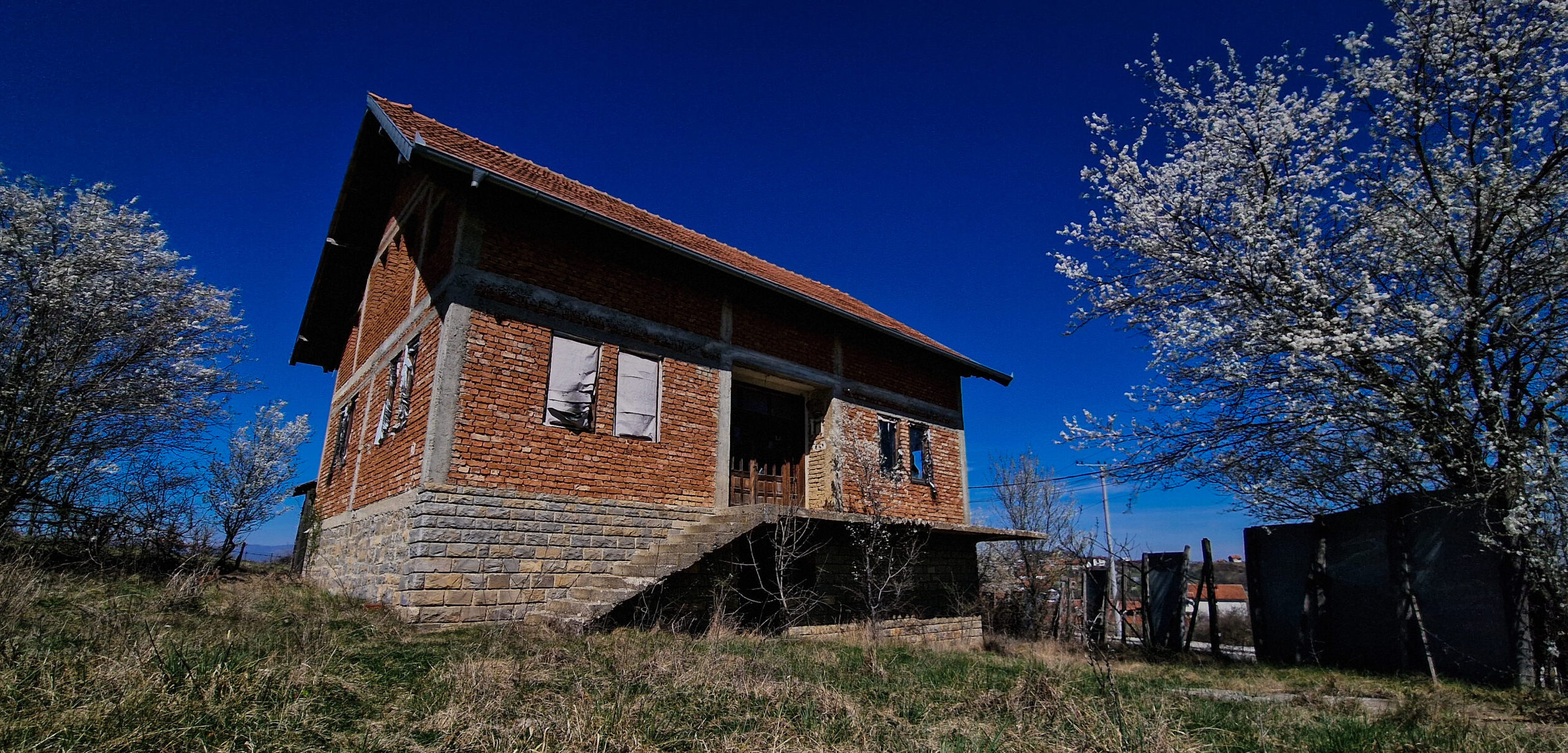
Abandoned house in Likoc of Skenderaj. Photo: Denis Slovinja/BIRN
Walls that never heard children’s voices
Blossom from the trees in springtime surrounded two lonely houses at the end of the road in the village of Likoc in Skenderaj.
It was strange to see the abandoned five-room building that in normal conditions could have accommodated a family of eight in which thousands of euros have been invested.
These walls have never heard children’s voices, mother’s songs and grandfather’s tales, but only the echo of stones that occupy a place on earth and hold the memory of the people stepping on them.
The Rrota family, neighbours who live near the houses in Likoc, knows their history.
The owners of these two houses built them before the war, despite being abroad at the time. They had hoped that their sons would return to live here. But their sons never returned.
“Instead, Serbian paramilitaries arrived during the war [in 1998-1999] and took over both houses,” 63-year-old Shaqë Rrota says.
There are graffiti with the names of the Serbs who destroyed the village. Shaqë Rrota says Serbian paramilitary forces spent the nights here.
“One night during the war, I went [out of the house] to get flour and saw them sawing wood,” recounted Rrota.
“They went out to the bottom of the hill and saw some people running away. Then they fired a burst of rifles at the civilians and wounded two girls,” he recalls.
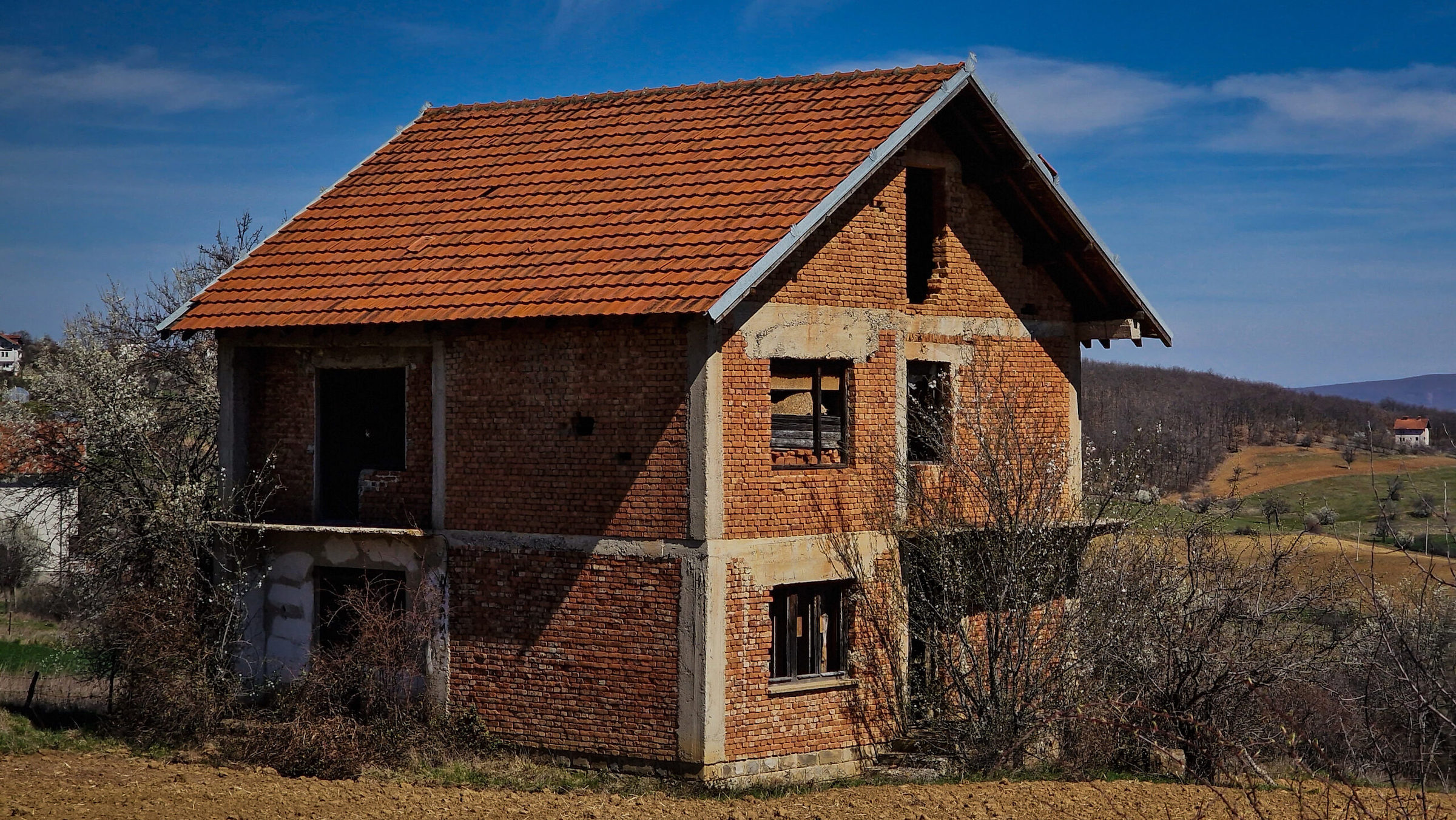
Abandoned house in Likoc of Skenderaj. Photo: Denis Slovinja/BIRN
On one of the interior walls, a large ugly artwork of a woman was drawn. Naked, in a position with the idea of humiliation and surrounded by old walls, the woman seems to be asking for help to escape.
“The war left consequences even after it ended,” Rrota says as he warns against going inside the house because it may still be mined.
Although the houses were never completely finished, in some window spaces cloth or boards have been attached to prevent people from looking inside the walls.
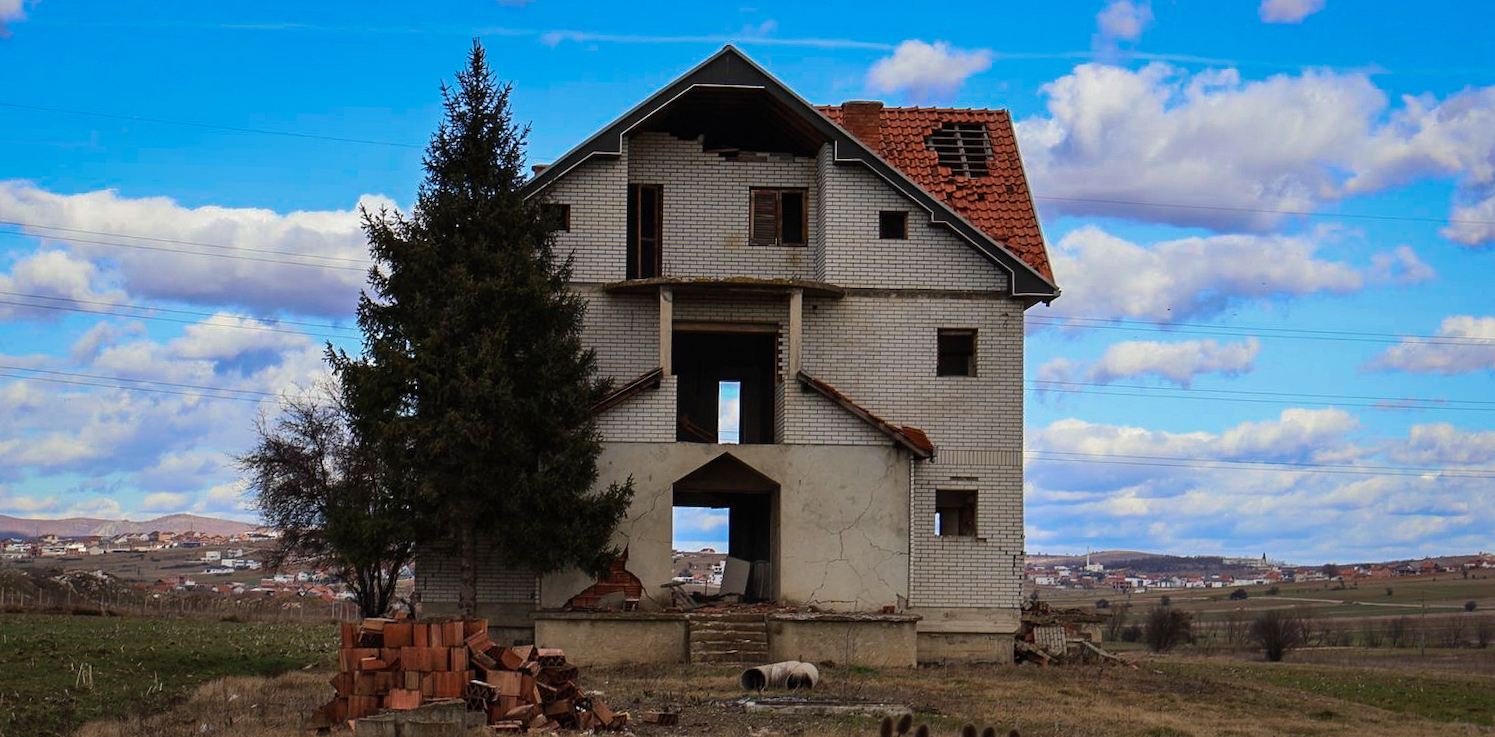
Abandoned house in the village of Budrikë e Poshtme in Gjilan. Photo: Afrim Ejupi/BIRN
Abandoned by Serbs
Many similar houses exist in Gjilan, a town in the south-east of Kosovo, as well. One is a white brick house on the way to Zhegër, in the Lower Budrikë [Budrikë e Poshtme] village.
The residents said these houses are mainly owned by Serbs who abandoned them during and after the war.
For visitors to the village, this house is just a landmark to find the village. Meanwhile, the residents see it as a symbol of trauma.
Jankovic Mimcilo, a resident of Lower Budrikë, and a relative of the owner of the house, says the house was built before the war and seven family members lived in it for a short time. Due to suspicions that it was mined during the war, they never returned to it and instead migrated to Switzerland.
“No one has lived there since 1999. That house looks like a relic of war trauma,” Mimcilo said.
“War is a war and we still have those traumas,” added the 58-year-old.
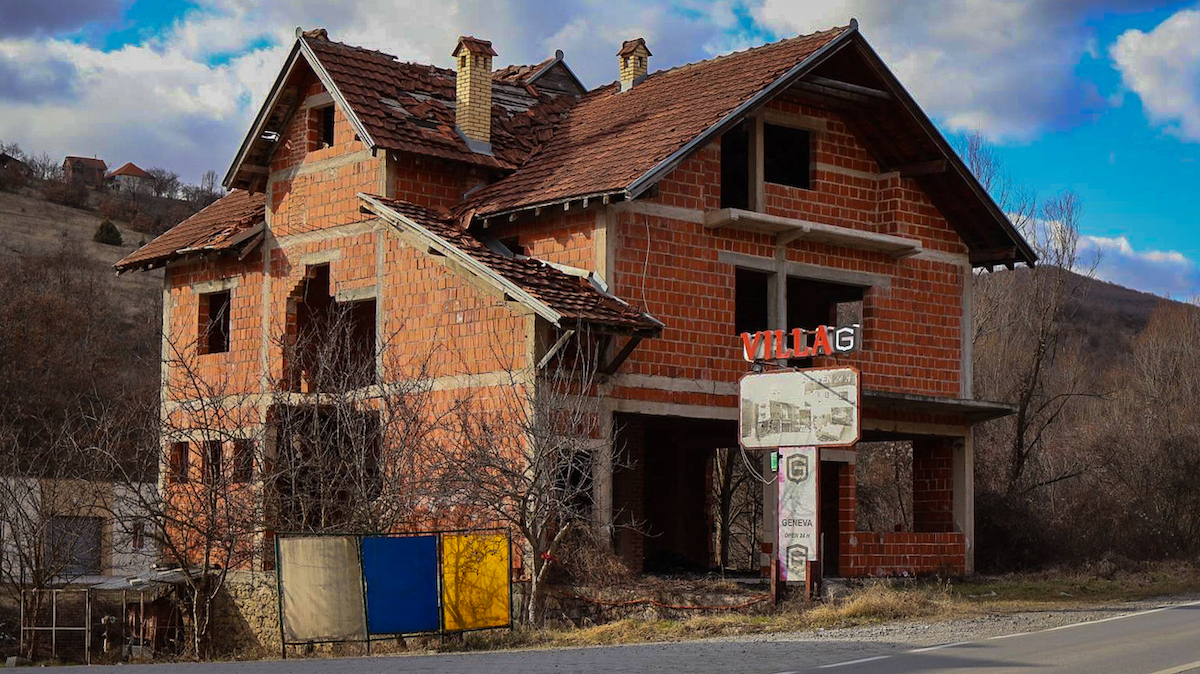
Abandoned house in the village of Parallovë in Gjilan. Photo: Afrim Ejupi/BIRN
At the edge of the village of Parallovë in Gjilan, Banush Gërbeshi runs his catering business next to an uninhabited house. Since he set foot in it 20 years ago, he remembers this house like the first day he saw it.
It has no windows, doors, or anything else.
“The house was probably built before the war by a Serb, but it was destroyed inside after the war. It looks new because no one has ever lived there … When we came here in 2004, it was the same as it is today,” he told Prishtina Insight.
“I am not afraid to enter this house. Those who know the owner have told me that he will not return from Switzerland,” he said.
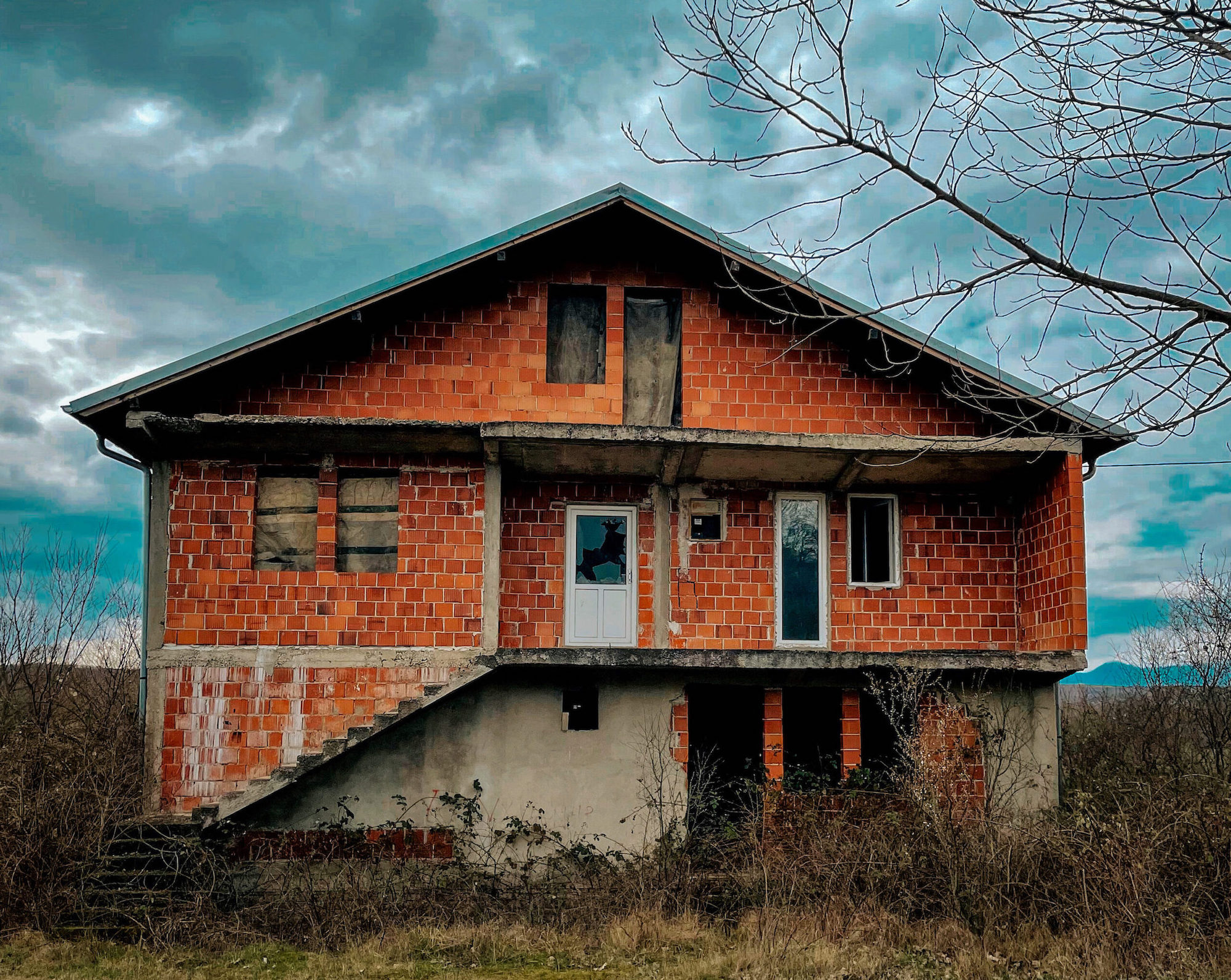
Abandoned house in Peja. Photo: Antigone Isufi/BIRN
Owners have migrated
The road to Peja, in north-west Kosovo, is longer than the one to Gjilan. The route to the destination is lined with many uninhabited houses. Somewhere there was a single house, and somewhere there were four houses next to each other.
In one part of the village of Vitomirica, there are four new houses in the same place, a place that resembled an oasis.
A few locals who know their history say that it is all about migration.
Another such house exists at the end of Loxhë village. Its owners also seem to have taken the path of migration and abandoned this house at the end of the road leading to the mountain.
A man in his sixties, Haxhi Rexhepi, who was crossing the street on a bicycle, knew the owner.
Rexhepi told Prishtina Insight that the house has existed since before the war, but since the death of the owner and his two sons, it has remained as it was built.
“The other family members have all gone abroad. Sometimes, his relatives plough the land when they come back on vacation,” said Rexhepi.
Fewer in number, there were similar houses in the villages of Pavlan, Zahaq and Qyshk in Peja. After the war, people did not return to the houses they had built, but bought flats in the city instead.
Empty houses filled with memories
A house on which human, financial and time resources are spent still has a purpose for which it was built.
Sociologist Avni Rudaku says another reason why these houses were not completed is that men who were at the age to serve in the military would be taken by force to serve in the Yugoslav army, but then emigrated and escaped. After a while, the rest of the family joined them as refugees from war, after being forcibly expelled from their homes.
When Kosovo Albanians remained unemployed in the 1990s, they felt safer only within their residences and uninhabited houses were places for social meetings, children’s hide and seek games, adults conversations, parties during the evenings lighting a fire near the house and even sexual exploration, according to Rudaku.
During the war, the Serbian police, army and paramilitaries used them for sexual abuse and rape, temporary shelter, temporary storage of stolen objects, skirmishes, checkpoints, temporary checkpoints, detentions and arrests arbitrary of Albanian civilians, drivers or bystanders.
“Even when these houses collapse and brand new ones are built, the memories and traumas remain,” said Rudaku.
Prishtina Insight contacted architects to get their perspective on the matter, but there is not enough information to create a perspective for these houses.
“There is little or no sociological or anthropological study of unoccupied houses, let alone any television news coverage of unoccupied houses as a danger to bystanders,” Rudaku said.
While the problem of empty houses is not new and many other European countries suffer from the same problem, the “ghost houses” of Kosovo’s villages remain a unique story.





